In the realm of North American avian diversity, the Trumpeter Swan and Tundra Swan stand as two elegant and captivating species, each possessing its own array of distinguishing features.
From size to vocalizations, plumage to migratory behaviors, these swans unveil a tapestry of adaptations that have enabled them to thrive in their respective habitats.
In this exploration, we delve into the nuanced distinctions that set the Trumpeter Swan and Tundra Swan apart, uncovering the intricacies that make them not only fascinating subjects for ornithologists but also vital components of the continent’s rich ecological fabric.
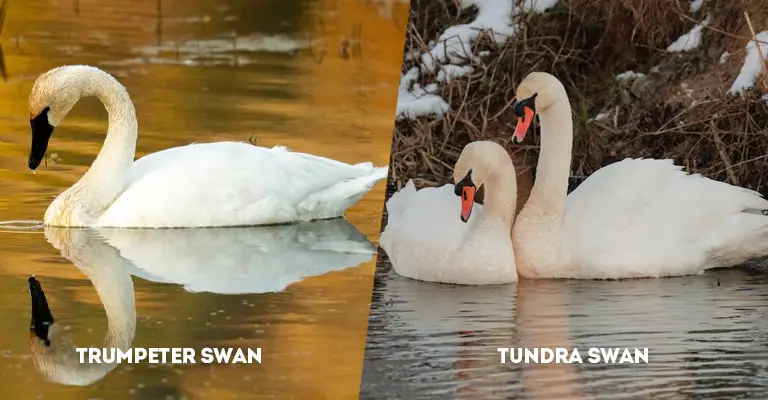
Key Differences Between Trumpeter Swan and Tundra Swan
Here are the key differences between Trumpeter Swans and Tundra Swans presented in a tabulated format:
Size
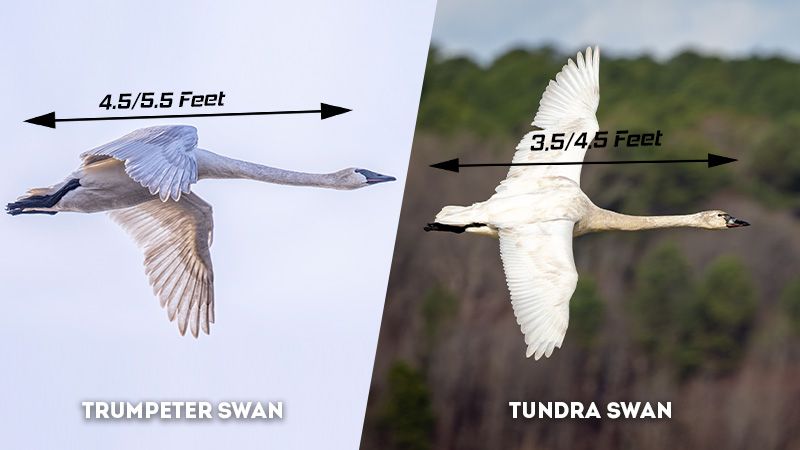
- Trumpeter Swan: The Trumpeter Swan, known for its grandeur, boasts a larger physique compared to its counterpart, the Tundra Swan.
With an average length ranging between 4.5 to 5.5 feet, and a commanding wingspan spanning 6 to 8 feet, the Trumpeter Swan stands as North America’s largest swan species. This impressive size lends it an air of majesty and dominance in its chosen habitats. - Tundra Swan: In contrast, the Tundra Swan, while equally elegant, holds a more modest stature. With an average length of 3.5 to 4.5 feet and a wingspan ranging from 5 to 6.5 feet, the Tundra Swan exhibits a smaller physical presence, often appearing daintier in comparison to its larger counterpart.
Wingspan
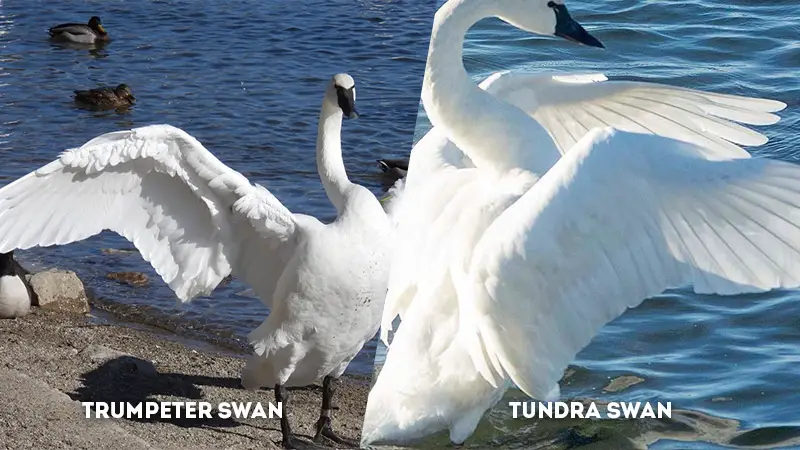
- Trumpeter Swan: The Trumpeter Swan’s magnificent wingspan, which can reach up to 8 feet, enables it to glide gracefully over bodies of water, showcasing its dominance over its chosen habitats.
This wingspan serves as a defining feature of the species, allowing it to traverse waterways with a sense of regal poise. - Tundra Swan: The Tundra Swan’s slightly smaller wingspan, reaching up to 6.5 feet, contributes to its agile and versatile flight pattern.
While not as expansive as the Trumpeter Swan’s, this wingspan allows the Tundra Swan to navigate through diverse landscapes during its extensive migratory journeys.
Plumage
- Trumpeter Swan: The Trumpeter Swan exhibits a timeless beauty with its pristine all-white plumage. This striking monochromatic coloration evokes a sense of purity and elegance, making the species a symbol of grace in North American wetlands.
- Tundra Swan: Similarly, the Tundra Swan dons the classic white plumage, but with an intriguing twist. Adding a touch of uniqueness, a small yellow patch in front of the eye sets the Tundra Swan apart from its cousin.
This subtle but distinctive feature adds a touch of color and individuality to the otherwise pristine white canvas.
Eye Patch
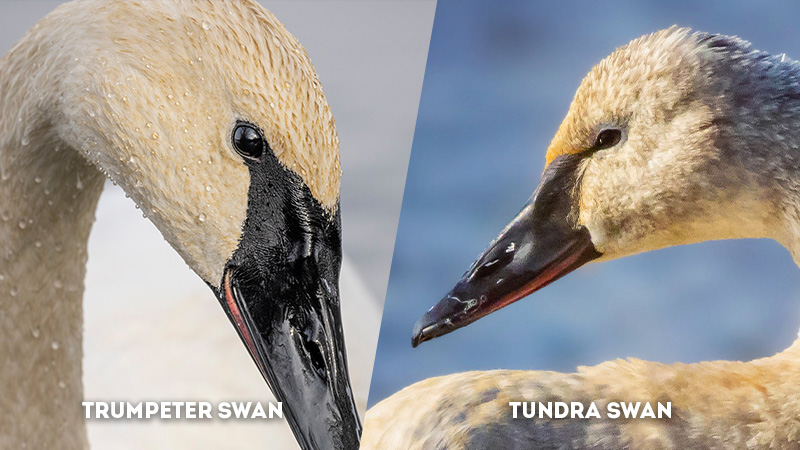
- Trumpeter Swan: The Trumpeter Swan, devoid of any eye patches, maintains a clean and unadorned appearance around its eyes. This contributes to its seamless, uninterrupted white countenance.
- Tundra Swan: The Tundra Swan carries a small but notable yellow patch in front of its eyes. This yellow marking provides a captivating contrast against the white plumage, drawing the observer’s gaze to this charming detail. The eye patch becomes a unique identifier for the Tundra Swan.
Bill Shape
- Trumpeter Swan: One of the most distinctive differences between the two species lies in the shape of their bills. The Trumpeter Swan features a broad black bill that forms a V-shape where it meets the forehead. This feature adds to the bird’s commanding appearance.
- Tundra Swan: In contrast, the Tundra Swan possesses a black bill that forms a U-shape where it connects to the forehead. This subtler curvature distinguishes it from its Trumpeter counterpart and showcases the intricate variations that nature can produce within closely related species.
Habitat
- Trumpeter Swan: The habitat preference of the Trumpeter Swan centers on freshwater bodies, including lakes, ponds, and slow-moving rivers. These expansive waterways provide ample space for the swans to gracefully navigate and find sustenance.
The Trumpeter Swan’s imposing size and stately presence make it well-suited to these serene aquatic environments. - Tundra Swan: The Tundra Swan exhibits a more diverse habitat range. During its breeding season, it occupies the Arctic tundra regions, utilizing the open wetlands and ponds for nesting.
However, its migratory nature also leads it to various habitats across North America during the winter months, including coastal estuaries, lakes, and agricultural fields.
Range
- Trumpeter Swan: The Trumpeter Swan primarily inhabits the northern parts of North America, with a significant presence in Canada and the northern United States. Its range includes regions where freshwater lakes and rivers dominate the landscape, providing the ideal conditions for its lifestyle.
- Tundra Swan: The Tundra Swan boasts a wide-ranging distribution due to its migratory behavior. It breeds in the Arctic tundra of North America and Eurasia, including places like Alaska and northern Canada.
However, its migratory path extends to various parts of North America during the winter months, making it a transient visitor to places as far south as the United States.
Neck Position
- Trumpeter Swan: The Trumpeter Swan is known for holding its long neck straight, enhancing its regal appearance as it glides across the water’s surface. This elegant posture is a characteristic hallmark of the species.
- Tundra Swan: In contrast, the Tundra Swan displays more variability in its neck position. While it can exhibit the straight-necked posture akin to the Trumpeter Swan, it also showcases moments where it curves its neck into graceful arcs, adding fluidity to its movements.
Migration
- Trumpeter Swan: The Trumpeter Swan’s migration pattern is less extensive compared to the Tundra Swan. While some populations might undertake short migratory journeys, many Trumpeter Swans are known to remain in their breeding territories year-round, particularly in regions where water remains open during winter.
- Tundra Swan: The Tundra Swan is renowned for its remarkable migratory endeavors. It embarks on one of the longest migrations undertaken by any swan species.
Breeding in the Arctic tundra during the summer, the Tundra Swan travels thousands of miles to more temperate areas in North America for the winter.
Vocalization
- Trumpeter Swan: The Trumpeter Swan derives its name from its distinctive vocalizations, which resemble the sound of a trumpet. Its calls are deep, resonant, and powerful, often echoing across bodies of water.
These vocalizations serve various purposes, from communication within flocks to establishing territory. - Tundra Swan: The Tundra Swan’s vocalizations differ notably from those of the Trumpeter Swan. Its calls are higher-pitched and possess a more melodious quality.
These musical calls contribute to the unique auditory landscape of wetlands and other habitats the Tundra Swan frequents, adding to the ambiance of these environments.
Conservation Status
- Trumpeter Swan: The conservation trajectory of the Trumpeter Swan is a story of successful recovery. Once facing the brink of endangerment due to overhunting and habitat loss, concerted conservation efforts have led to the rebound of Trumpeter Swan populations.
Through habitat restoration, legal protections, and captive breeding programs, these majestic swans have managed to escape their endangered status and regain stable population levels. - Tundra Swan: Unlike the Trumpeter Swan, the Tundra Swan’s conservation status is less of a concern. Its populations remain stable, and the species is not currently listed as threatened or endangered.
The Tundra Swan’s adaptability to a range of habitats and its extensive migratory behaviors have likely contributed to its continued viability.
Distribution
- Trumpeter Swan: The distribution of the Trumpeter Swan is predominantly concentrated in the northern regions of North America.
It thrives in the freshwater environments of Canada and the northern United States, showcasing a preference for habitats characterized by expansive lakes and slow-moving rivers. - Tundra Swan: The Tundra Swan boasts a broader distribution due to its migratory tendencies. Its breeding grounds extend across the Arctic tundra of North America and Eurasia, while its wintering range spans a wider territory, including parts of the United States.
This migratory behavior exposes the Tundra Swan to a more diverse array of habitats.
Breeding Grounds
- Trumpeter Swan: Trumpeter Swans breed in a variety of wetland habitats, often selecting lakes and ponds with ample aquatic vegetation for nesting. Their choice of breeding grounds aligns with their larger size and preference for open-water areas.
- Tundra Swan: The Tundra Swan’s breeding grounds are primarily situated in the Arctic tundra regions. These open wetlands and ponds provide suitable conditions for nesting during the short Arctic summer.
The species’ ability to successfully reproduce in these challenging environments speaks to its remarkable adaptability.
Bill Color
- Trumpeter Swan: The Trumpeter Swan’s bill is a striking black, contrasting vividly with its white plumage. The combination of the black bill and white feathers enhances the swan’s regal appearance, making it a captivating sight in its aquatic habitats.
- Tundra Swan: Similar to the Trumpeter Swan, the Tundra Swan also possesses a black bill. This consistent bill coloration aligns with its classic white plumage, creating a harmonious color palette that complements its surroundings.
Bill Size
- Trumpeter Swan: The Trumpeter Swan’s bill is notable for its size and shape. The bill is broad and substantial, a feature that contributes to its impressive and commanding presence. Moreover, the bill forms a distinct V-shape where it meets the forehead, adding to the swan’s distinctive profile.
- Tundra Swan: The Tundra Swan’s bill size is comparatively more delicate. While still possessing a black bill, the Tundra Swan’s bill features a U-shape connection with the forehead. This subtle difference in bill structure reflects the nuanced variations between the two swan species.
Leg Color
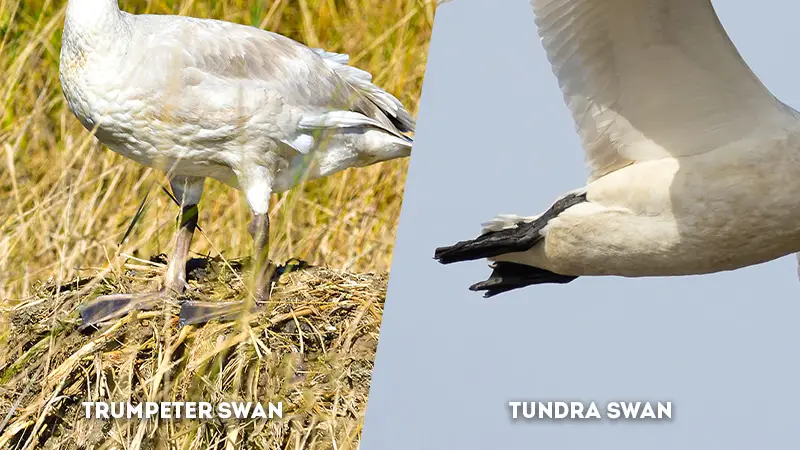
- Trumpeter Swan: The Trumpeter Swan’s legs are consistent with the overall color scheme of the species – they are black. This dark hue complements the swan’s plumage and bill, contributing to its elegant and unified appearance.
- Tundra Swan: Similar to the Trumpeter Swan, the Tundra Swan also possesses black legs. This commonality in leg color underscores the shared characteristics between the two species, despite their distinct features in other aspects.
Feeding Behavior
- Trumpeter Swan: Trumpeter Swans are grazers that predominantly feed on aquatic plants and algae found in the freshwater habitats they inhabit. Their long necks and graceful movements allow them to reach beneath the water’s surface to access their preferred food sources.
- Tundra Swan: The Tundra Swan’s feeding behavior aligns with that of the Trumpeter Swan. It primarily feeds on aquatic vegetation, which serves as its primary source of sustenance.
This shared feeding behavior underscores the ecological role that swans play in maintaining aquatic ecosystems.
Behavior
- Trumpeter Swan: Trumpeter Swans are known for their behavior of often being solitary or forming small groups. This behavior might stem from their territorial tendencies and their preference for specific feeding areas within their chosen habitats.
- Tundra Swan: The Tundra Swan’s behavior contrasts with that of the Trumpeter Swan, as it often forms larger flocks, especially during migration.
These flocks provide safety and a sense of community during their extensive journeys, contributing to the species’ survival and ability to navigate changing environments.
Migratory Path
- Trumpeter Swan: The Trumpeter Swan’s migratory behavior is less pronounced compared to the Tundra Swan. Some populations remain resident in their breeding territories year-round, while others might undertake shorter migrations to find open water during the winter.
- Tundra Swan: The Tundra Swan’s migratory path is a remarkable feat of endurance. Breeding in the Arctic tundra, these swans undertake long migrations from their northern breeding grounds to more temperate regions in North America for the winter.
This migration often spans thousands of miles and involves traversing diverse landscapes.
Feeding Range
- Trumpeter Swan: Trumpeter Swans tend to feed relatively close to their breeding sites, focusing on the aquatic vegetation present in their chosen habitats.
Their feeding range is often influenced by the availability of suitable food sources within their local areas. - Tundra Swan: The Tundra Swan’s feeding range is significantly wider due to its migratory behavior. During its winter migration, it covers a broader territory, utilizing various wetland habitats for feeding.
This adaptability to different environments allows the Tundra Swan to access a diverse range of food sources during its travels.
Trumpeter Swan Vs Tundra Swan: Comparison Table
| Feature | Trumpeter Swan | Tundra Swan |
|---|---|---|
| Size | Larger (4.5 – 5.5 ft) | Smaller (3.5 – 4.5 ft) |
| Wingspan | 6 – 8 ft | 5 – 6.5 ft |
| Plumage | All-white | All-white with yellow patch |
| Eye Patch | Absent | U-shaped where it meets the forehead |
| Bill Shape | Small yellow patch in front of the eye | Arctic tundra migrates to the south |
| Habitat | Lakes, ponds, slow rivers | Various habitats across North America |
| Range | North America, Canada, northern US | Long migrations from the Arctic to south |
| Neck Position | Straight | Variable |
| Migration | Partially migratory | Long migrations from the Arctic to the south |
| Vocalization | Deep, trumpet-like calls | Higher-pitched, musical calls |
| Conservation Status | Recovered from endangered status | Stable populations |
| Distribution | Mainly northern North America | Wide distribution across North America |
| Breeding Grounds | Limited to certain regions | Arctic tundra breeding |
| Bill Color | Black | Black |
| Bill Size | Broad | U-shaped connection with forehead |
| Leg Color | Black | Black |
| Feeding Behavior | Grazes on aquatic plants and algae | Feeds on aquatic vegetation |
| Behavior | Often solitary or in small groups | Often forms larger flocks |
| Migratory Path | Limited migration | Long migratory paths |
| Feeding Range | Relatively close to breeding sites | Wide range during migration |
Frequently Asked Questions
Trumpeter Swans are known for their deep, trumpet-like calls that resonate across their habitats, while Tundra Swans produce higher-pitched, more musical calls. These distinct vocalizations reflect each species’ unique communication patterns and contribute to the auditory ambiance of wetlands and water bodies.
Trumpeter Swans are generally less migratory, with some populations remaining in their breeding territories year-round. In contrast, Tundra Swans embark on extensive migrations from their Arctic breeding grounds to more temperate regions of North America for the winter. This journey showcases their remarkable adaptability and navigation skills.
Yes, there are differences in their social behaviors. Trumpeter Swans are often seen as solitary or in small groups, possibly due to territorial tendencies. Tundra Swans, on the other hand, tend to form larger flocks, especially during migration. These flocks provide safety, companionship, and a sense of community during their travels.
Both species play a crucial role in maintaining the health of their ecosystems by feeding on aquatic vegetation and algae. Their grazing behaviors help control plant growth, improve water quality, and create habitats for other aquatic organisms. Through their feeding, they contribute to the balance of these delicate ecosystems.
Trumpeter Swans have witnessed successful recovery efforts, transitioning from endangered to more stable populations due to focused conservation initiatives. Tundra Swans, with their stable populations, often benefit from habitat preservation and broader wetland conservation efforts, contributing to the overall health of the ecosystems they inhabit.
To Recap
In the grand symphony of nature, the Trumpeter Swan and Tundra Swan are harmonious notes, contributing their unique melodies to North America’s diverse landscapes.
Through differences in size, migratory paths, feeding behaviors, and more, these swans exemplify the remarkable adaptability and resilience of avian life.
Their conservation stories, vocalizations, and interactions with ecosystems underscore their roles as indicators of environmental health.
As we observe these majestic creatures, we are reminded of the delicate balance of nature and the intricate web of life they embody, inspiring us to preserve and cherish the beauty of our world.
